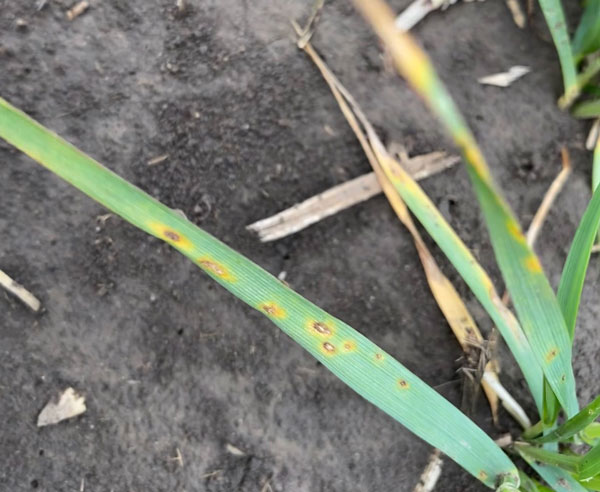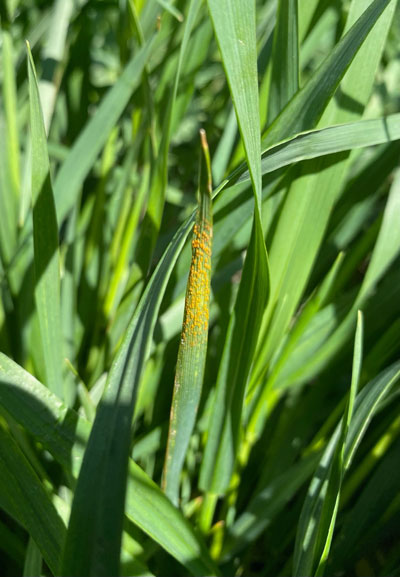2021 Wheat Stripe Rust
Rust diseases are among the most widespread and economically important diseases in the wheat crop. The fungi causing diseases such as leaf rust, stripe rust and stem rust are known for their ability to increase rapidly. The greatest yield loss occurs when these diseases occur before the heading stage of development. Early detection, proper identification, and disease management are critical.
Stripe rust commonly affects the leaf blades. The lesions are normally yellow to orange in color and are small, round, and blister-like that merge to form stripes the length of the leaf. These lesions reduce the photosynthetic area reducing the production of sugars for the plant.
Fungicides can best protect the critical growth stages from disease when applied between full emergence of the flag leaf and flowering. Fungicide applications made before flag leaf emergence generally result in less disease control on the upper leaves during grain development and smaller yield responses.
---------------------------------------------------------------------------------
KSRE Agronomy eUpdate - April 15th, 2021
With wheat at or approaching flag leaf in southern Kansas, producers are considering the use of fungicides to manage foliar diseases and protect the yield potential of their crop. Susceptible varieties are at highest risk for yield loss when environmental conditions are favorable for disease development. Variety resistance ratings can be checked in this publication: https://bookstore.ksre.ksu.edu/pubs/mf991.pdf. K-State research has found that a single application can result in a 4-13% yield increase in susceptible varieties relative to wheat that remained untreated.
Wondering about fungicide recommendations for different diseases? The publication Foliar Fungicide Efficacy for Wheat Disease Management has been updated for 2021 and can be found at: http://www.bookstore.ksre.ksu.edu/pubs/EP130.pdf. The recommendations in this publication reflect several years of head-to-head comparisons of products in Kansas and many other wheat producing states.
Considerations for managing foliar diseases
Timely disease scouting is the first step in assessing the need for foliar fungicide applications. Important foliar diseases for Kansas wheat producers this year include stripe rust, leaf rust, tan spot, and leaf blotch. Producers should scout for symptoms of foliar diseases in the upper canopy, and particularly near the flag leaves of primary tillers. Damage to the flag leaf is most associated with reduced yield. If symptoms are present when scouting, a foliar fungicide application may be considered. There are many fungicides available in Kansas that provide very good to excellent control of foliar diseases and producers should consult the updated Foliar Fungicide Efficacy for Wheat Disease Management publication for details.
Managing tan spot and stripe rust
Tan spot and other leaf spot diseases (such as Septoria tritici blotch), are starting to show up in the lower canopy in parts of Kansas that have received rainfall over the past several weeks (Figure 1). They may be most problematic in fields with wheat residue, as these pathogens survive through the winter in wheat straw. When it rains, spores will be splashed from residue onto the canopy. This is why we typically see symptoms on the lower leaves first. Tan spot will only be a problem for yield when the upper leaves, particularly the flag leaves of primary tillers, become infected. Fungicide applications should be held until flag leaf emergence (Feekes 8) to fully maximize benefits. Several products in the updated Foliar Fungicide Efficacy ratings document are rated very good to excellent for tan spot control (http://www.bookstore.ksre.ksu.edu/pubs/EP130.pdf).

Figure 1. Characteristic symptoms of tan spot on the lower leaves. Symptoms start as a small, round or diamond-shaped brown spots. As symptoms progress, a yellow halo will form around spots and spots may coalesce. Photo by Kelsey Andersen Onofre, K-State Research and Extension.
Stripe rust has recently been reported at very low levels in Southeast Kansas, but there have been no reports of stripe rust moving into the upper canopy yet (Figure 2). Similar to tan spot, stripe rust fungicide applications are most beneficial when made between flag leaf emergence (Feekes 8) and heading (Feekes 10) to a susceptible variety. There are many products that are rated very good or excellent for stripe rust control, but it is important to know that fungicides in the strobilurin family (Group 11) are not as effective when applied after symptoms have already appeared.
It is important to carefully consult fungicide label recommendations prior to product application.

Figure 2. Characteristic symptoms of stripe rust. Stripe will start as yellow flecking on leaves, but soon orange pustules will erupt on the leaf surface containing classic orange spores. Pustules will typically form in lines, or stripes, on the leaf surface. Photo by Kelsey Andersen Onofre, K-State Research and Extension.
Kelsey Andersen Onofre, Extension Plant Pathologist
andersenk@ksu.edu
Learn more here!
____________________________________________________________________
Contact Tyree Ag today to discuss which fungicide
product is best to meet your needs.

Toll Free: 866-897-3324
*Current customers please contact your salesman or call the office, where your information
will be given to a salesman who will contact you directly.
________________________________________________________________________
KP
